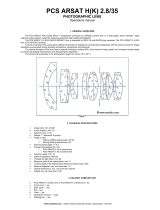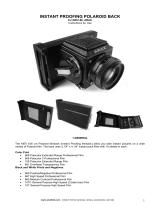Page is loading ...

www.araxfoto.com - medium format cameras, lenses, accessories , services
PCS ARSAT H(K) 4.5/55
PHOTOGRAPHIC LENS
Operations manual
1. GENERAL GUDIELINES
The PCS ARSAT 4,5/55 (PCS - Perspective Correction by Shifting) is designed for professional photography with medium format
SLR cameras: KIEV-6С, KIEV-60, KIEV 88, ARAX, PENTAGON SIX, SALUT.
This camera lens is a wide-angle, nine element complex high aperture optical system (pic.1), producing high quality photographs.
The lens has an optical block shifting mechanism in parallel to the film plane that provides the photographer with the ability to
correct the image perspective. In architectural and product photography, these lenses offer a means to produce unique results, normally
associated with the use of large format cameras..
The lens has a special multi-layer coating (МС), improving image quality and increasing contrast range by enhancing integral light
transmission and decreasing the dispersion of passing light.
The camera lens operates in the temperature range from minus 15 to 45° С. (5 to 113 F)
Figure 1
2. TECHNICAL SPECIFICATIONS
• Image ratio, mm: 6х6
• Focal distance, mm: 55
• Aperture ratio: 1:4,5
• Aperture limit: 22
• Angle of view:
o Without shifting optical block: 69
o
o Having shifting optical block: 84
о
• Short focusing range, m: 0,5
• Flange focal distance for, mm:
o KIEV-6S and KIEV-60: 74
o KIEV-88: 82,1
• Threads for light filters, mm: М72х0,75
• Maximum shift of the axis, mm: 12
• Turning angle of the lens relative to bayonet axis: 360
о
• Maximal diameter, mm, not more than: 95
• Length, mm, not more than: 97,5
• Weight, kg, not more than: 0,90
3. DELIVERY COMPLETE SET
• Lens -1 ea.
• Front cover -1 ea.
• Back cover - 1 ea.
• Lever (only for camera lens PCS ARSAT B) - 1 ea.
• Case - 1 ea.
• Operations manual - 1 copy.
• Packing box - 1 ea.

www.araxfoto.com - medium format cameras, lenses, accessories , services
4. OPERATING INSTRUCTIONS
4.1. Lens installation and removal
Lens installation and removal instructions are detailed in the individual operations manuals for the КIEV-6С, КIEV-60, КIEV 88,
ARAX, and PENTAGON SIX cameras.
4.2 Focusing
Set the aperture by rotation of the ring 5 (fig.2) until superposition of the selected value with the index on the fixed ring occurs. For
full opening of the aperture (during image focusing) turn the ring 4 clockwise (if you look from the camera’s side) up to the stop. When
photographing the subject while not interrupting to monitor the image in the camera viewfinder’s vision field, turn the ring 4 counter-
clockwise up to the stop or press the wire’s button screwed into the seat 6 – after that selected value of aperture will be set. Then press
the release button on the camera.
Figure 2.
4.3. Aperture operation
Focusing is done at maximum aperture by rotating focusing ring 3 with focusing scale until you receive a clear image of the subject
as observed in the viewfinder.
Focusing scale 2 serves as a secondary focusing aid if the approximate distance to the subject is known.
The depth of field is determined by the focal distance using additional scale and viewed by the subject’s image details on the matte
groundglass surface in the viewing field of the viewfinder by rotating ring 4 counter-clockwise (if you look from the camera’s side) up to
the stop.
4.4. Lens shifting
The lens optical block shift is performed by rotating ring 1 with the shift scale (in millimeters). The maximum axis shift (figure 3)
corresponds to the ring 1 turn (figure 2) by 90°. The direction of the shift is selected by rotating the lens in relation to the bayonet axis.
To rotate the lens pull aside locking button 7 towards the camera. The lens can then be rotated around the bayonet axis by 360°
and locked at every 15° interval.
Figure 3.

www.araxfoto.com - medium format cameras, lenses, accessories , services
4.5. Distortion correction
When photographing high buildings from ground level, the distance from the lens to the top and bottom of the subject are
different. As a result of this, the distortion in this case appears as a convergence of the parallel lines upwards (Fig. 4), and vice versa:
when photographing from above downwards, the parallel sides of the building will be converging downwards.
Fig.4
Fig.5
Sometimes instead of image correction, with the intention of creating special effects, the occasion arises to create even more
exaggerated distortions. In this case, you would incline the camera upwards and shift the lens in the opposite direction.
4.6. Reflection elimination
When photographing objects with reflective surfaces, the reflection of the photographer and camera can appear in the image. (Fig.
6А). Carrying over the camera angle to one side and shifting the lens to the opposite side, while retaining the parallelism of the object
and film planes allows you to eliminate the reflection and still preserve the rectangular composition of the image (Fig. 6B).
Fig.6А Fig.6B

www.araxfoto.com - medium format cameras, lenses, accessories , services
4.7. Panoramas
While using PCS ARSAT 4,5/55 lens you can produce panoramic photographs. For that, make two exposures from one camera
angle: first one – with maximum shift of the lens to the right, and a second one – with maximum shift to the left. Combining both images
during photocopying will provide you with a single panoramic photograph (Fig. 7), which corresponds to a negative with an image
format of 6х9 сm and normal perspective.
Fig.7
4.8. Obstruction elimination
Obstructions like trees or poles located relatively closely to the camera and appearing at the image edge can be eliminated by
means of lens shifting and rotating the camera.
For instance, the obstruction (pole) is located at the image edge on the right. See Fig. 8А. To eliminate it, shift the lens to the right,
and rotate the camera angle to the left until full disappearance of the pole. (Fig. 8B)
Fig.8А Fig.8B

www.araxfoto.com - medium format cameras, lenses, accessories , services
5. LEVER USE
The PCS ARSAT-В 4,5/55 (for КIEV-88 and SALUT) lenses are equipped with a special lever which is installed in the tripod socket
of the KIEV-88 camera and allows the release of the shutter in those cases when the camera’s release button is overlapped by the
shifted lens.
6. STORAGE AND MAINTENANCE RULES
The camera lens is a complicated optical device and it requires careful operation and maintenance. Protect it against impacts,
sudden fluctuations in temperature and also against dust and moisture.
Upon entrance into a warm room from outside frost do not open the lens immediately. Let it warm up to prevent condensation on
the optical surfaces.
Remove dust and moisture from the lens with a soft brush, cloth, or a wad of cotton wool wetted in ether-spirit mixture.
Note: During inspection it can be found out that some lenses may have small bubbles in the glass, insignificant scratches
and fluffs which do not in any way affect image quality and have been accepted by the standard.
Version 2 (5-25-2003)
ARAX Inc.
Kiev, Ukraine, 01042
www.araxfoto.com
/















